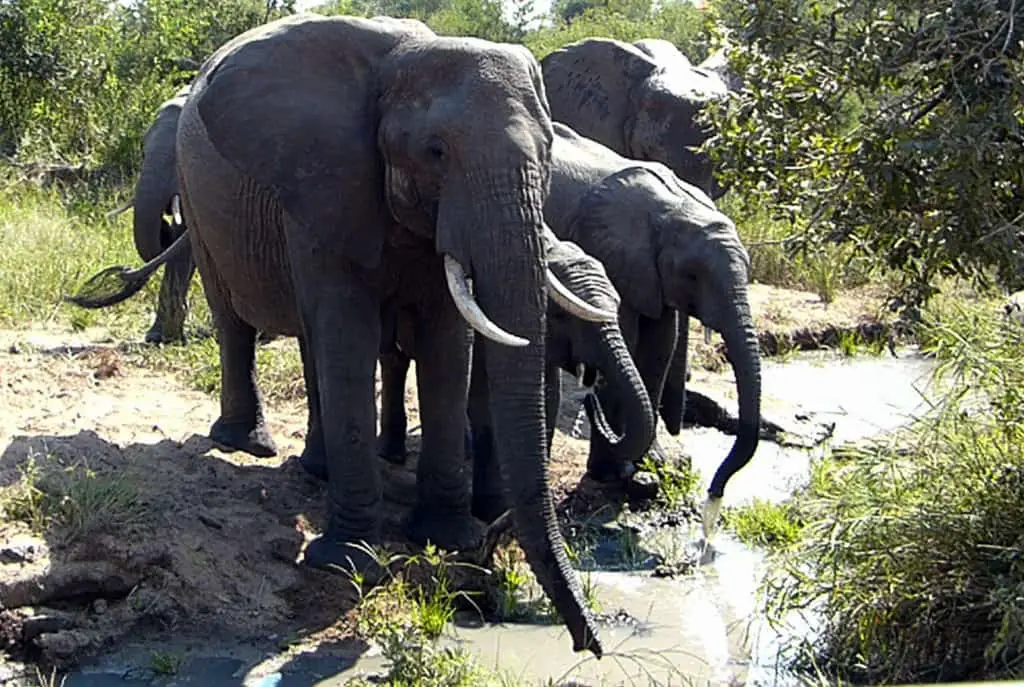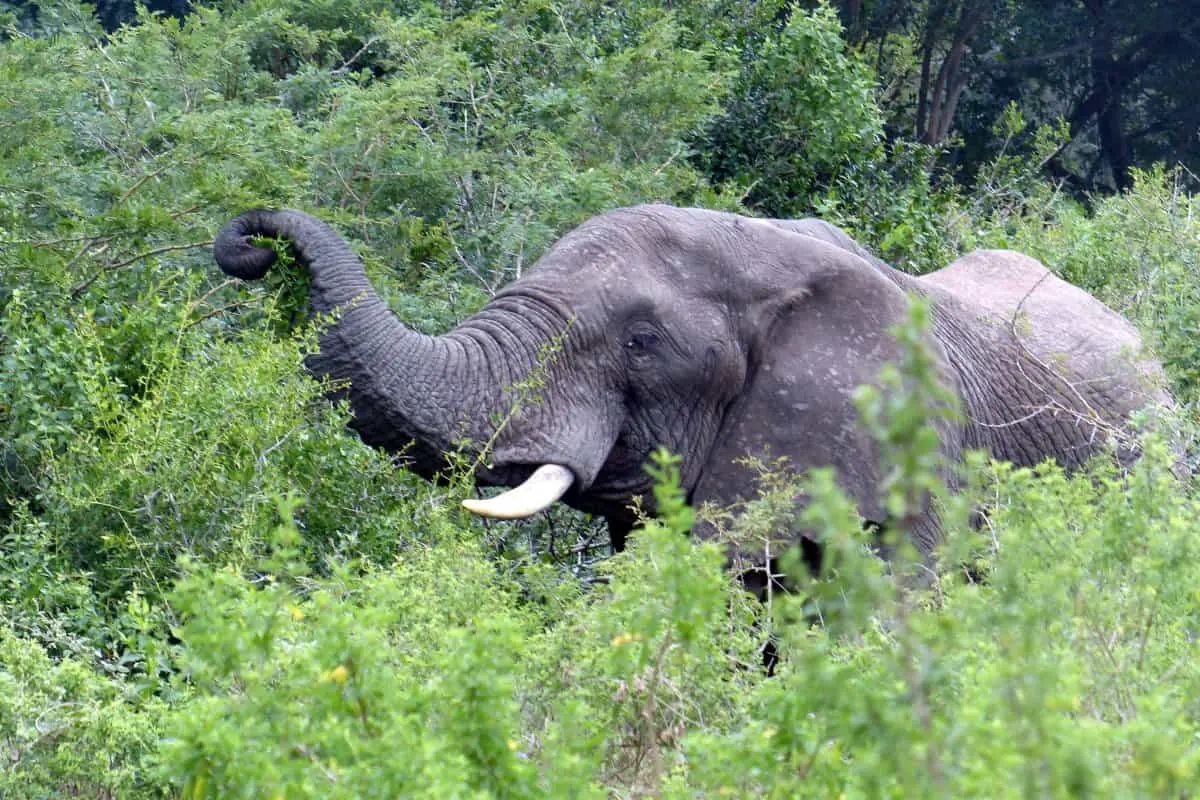- Elephant trunks are actually a combination of the nose and upper lip of the elephant.
- They are incredibly strong and can lift objects weighing up to 700 pounds (317 kilograms).
- Elephant trunks have up to 150,000 muscles, making them extremely flexible and dexterous.
- They can be used for various tasks such as drinking water, grabbing food, and even greeting other elephants.
- Elephants use their trunks to suck up water and then spray it into their mouths for drinking.
- The trunks are also used for communication, with elephants using them to trumpet, rumble, and make other sounds.
- Elephant trunks are sensitive enough to pick up small objects like a single grain of rice.
- These incredible appendages can be up to 7 feet (2.1 meters) long and weigh around 300 pounds (136 kilograms).
- The tip of an elephant’s trunk is like a finger and can be used to grab and manipulate objects with precision.
- When not in use, elephant trunks can be curled up like hoses, making them more compact and easier to carry around.
Anatomy of Elephant Trunks
The elephant trunk, an incredible fusion of the upper lip and nose, is a testament to the extraordinary adaptations found in these majestic animals. The anatomy of an elephant trunk, which lacks any bones or cartilage, consists of a muscular hydrostat, a powerful arrangement of muscles that makes it extremely flexible and strong.
You may be amazed to learn that elephants use their trunks for a plethora of purposes. Besides breathing, they use their trunks for smelling, drinking, and even spraying water onto their bodies during bathing. Equipped with specialized sensors near the nostrils, the trunk can pick up the faintest of scents, and elephants can even raise their trunks in the air to enhance their smelling capabilities.
On the tip of the trunk, you will find “fingers” that vary between Asian elephants and African elephants. Asian elephants possess one finger-like projection, while African elephants have two. These fingers are highly sensitive and adapted to assist these animals in grasping a wide range of objects. An elephant’s trunk can deftly handle even small items, like a single blade of grass.
The skin of the elephant’s trunk is quite thick, providing durability and strength for heavier tasks. Elephants can use their trunks to push, pull, lift, and uproot large obstacles like trees. However, this tough exterior does not come at the expense of sensitivity. The interior of the trunk is densely packed with nerve endings, making it an essential sensory organ that helps elephants explore and understand their surroundings.
Functions and Uses of Trunks
The elephant’s trunk serves as a versatile, multipurpose tool in their daily lives. It plays essential roles in their basic functions, such as eating and drinking, as well as social interactions and communicating with other elephants.
When it comes to drinking, an elephant uses its trunk as a straw, sucking up the water and then spraying it into its mouth. This powerful tool can hold up to eight liters of water at a time, allowing them to quench their thirst efficiently. In addition to drinking, the trunk is also vital for feeding.

Elephants utilize their trunks to grab and lift branches, leaves, and other vegetation, making it much easier for them to eat. The trunk’s impressive reach helps them access food sources that might otherwise be out of reach.
Breathing is another crucial function of the elephant’s trunk. This elongated nose acts as a snorkel when they swim in deep water, allowing them to breathe while keeping their heads submerged. It also provides excellent maneuverability, helping them navigate their environment with ease.
The elephant’s trunk is an essential part of their sense of smell. By smelling the air around them, they can detect the scent of food and water sources or sense potential dangers or threats nearby. Their extraordinary sense of smell also helps them communicate with other members of their social group.
The trunk’s role in social interactions is crucial to the well-being of these highly social animals. By touching and stroking each other with their trunks, they engage in comforting, greeting, or reassuring behaviors that help maintain strong bonds within their family groups. Elephants also use their trunks to self-soothe, especially when they’re young and still developing emotional regulation skills.
Elephant Trunks in Communication and Social Interaction
Elephants are highly social animals that rely on their extraordinary trunks to communicate and interact with each other in various ways. Their trunks play a crucial role in activities such as playing, greeting, and comforting.
When it comes to playing, you may observe elephants using their trunks to engage in friendly sparring or wrestling with other members of the herd. These playful trunk encounters serve not only as a source of entertainment but also as a means for developing social bonds and trust within the group.
In terms of greeting, elephants often intertwine their trunks, a gesture akin to a human handshake. This action can occur between close acquaintances or between elephants that are meeting for the first time, as a means of establishing or reaffirming their connections.
Beyond playing and greeting, elephants use their trunks to provide comfort to one another during distressing situations. They may wrap their trunks around a younger or injured herd member, offering both physical support and a reassuring touch.
Elephants use their trunks for sound production and reception. They are known to produce a variety of vocalizations, many of which are facilitated by their trunks. These sounds can range from high-frequency calls, such as trumpeting, to low-frequency rumbles that travel through the ground and can be sensed by other elephants using their highly sensitive trunks.
Differences Between Asian and African Elephant Trunks
Elephant trunks are truly remarkable, but did you know that there are differences between the trunks of African and Asian elephants? Understanding these differences can help you appreciate each species in a new light.
African elephants generally have larger trunks in comparison to their Asian counterparts. This is mainly due to the fact that African elephants are larger overall, with both males and females measuring a bit taller and heavier than their Asian relatives. Their size difference also translates to a varying number of muscles in their trunks, and this is where things get quite interesting.
How Many Muscles are in an Elephant’s Trunk?
African elephants are estimated to have around 150,000 muscles in their trunks, while Asian elephants are believed to have approximately 100,000 muscles in their trunks. This is based on a study by Rui Diogo and colleagues published in the journal Anatomical Record in 2014 that estimated the number of muscles in elephant trunks based on dissections of elephant specimens.
Despite having fewer muscles, Asian elephants are still able to perform delicate tasks, thanks to the specialized tips of their trunks. African elephants have two finger-like tips at the end of their trunks, whereas Asian elephants have only one. This anatomical difference means that Asian elephants rely on the dexterity of their single tip to grasp objects, whereas African elephants make use of both.
In addition to anatomical differences, the habitats of African and Asian elephants greatly impact their behavior and interactions with their trunks. African elephants primarily inhabit savannas, marshlands, and deserts, while Asian elephants dwell in tropical evergreen forests. As a result, they have adapted their trunk usage to better suit their respective environments.
So the next time you’re observing these fascinating creatures, take a closer look at their trunks, their behavior, and their unique adaptations to their environments. With this newfound knowledge, you’re sure to appreciate the intricacies of the majestic African and Asian elephants even more.
Unique Things Elephants Do With Their Trunks
Ever seen an elephant munch on a rutabaga or grab a fish delicately? Because their trunks contain thousands of muscles, they have incredible dexterity. This enables them to pick up small objects like a single tortilla chip or peanuts and also manipulate large branches or logs.
Elephants use their trunks as versatile water sprayers. They can draw up to 8 liters of water, then spray it over their bodies to cool down or into their mouths to drink. Besides water, they also use their trunks to take dust or sand showers, enhancing their skin health and protecting them from parasites.
You may laugh at the idea of an elephant using its trunk to sleep. Surprisingly, elephants’ trunks play a role in sleep too. They use it as a leg rest while lying down or to support their heads while standing and dozing off.
Consider their trunks as a lifeline while swimming. When navigating through water, elephants use their trunks like snorkels, keeping the tip above the surface to breathe, while the rest of their body is submerged.
As social animals, elephants use their trunks to communicate affection and greetings within their herd. They intertwine and touch their trunks to exchange smells, a form of communication that indicates their bond and strengthens their relationships.
Development of Trunk Skills in Young Elephants
A study on the biomechanics of the trunk reveals that young elephants need to learn a range of fine motor skills, just as human youngsters develop dexterity with their hands. Let’s explore the crucial stages of trunk development in baby elephants and their journey to master this unique appendage.
When a baby elephant is born, they often have little control over their trunk. At this early stage, their trunk might even seem like a burden, as it tends to dangle and sometimes trip the calf. However, with time and practice, they acquire increasingly more control over this appendage.
Under the watchful eye of their mother elephant, young elephants learn to elongate, hold, and manipulate objects with their trunks. They begin by using their trunks to explore their surroundings, touching and holding onto fellow herd members or mimicking the movements of their elders.
In addition to using the trunk for grasping, young elephants learn to master its utility for feeding and drinking. Starting with imitating the mother elephant, the calf learns to hold grass, strip leaves from branches, and scoop up water into their mouths.
References
Diogo, R., Abdala, V., Lonergan, N., Wood, B., & Polk, J. (2014). From fish to modern humans – comparative anatomy, homologies and evolution of the head and neck musculature. The Anatomical Record, 297(3), 475-495.


